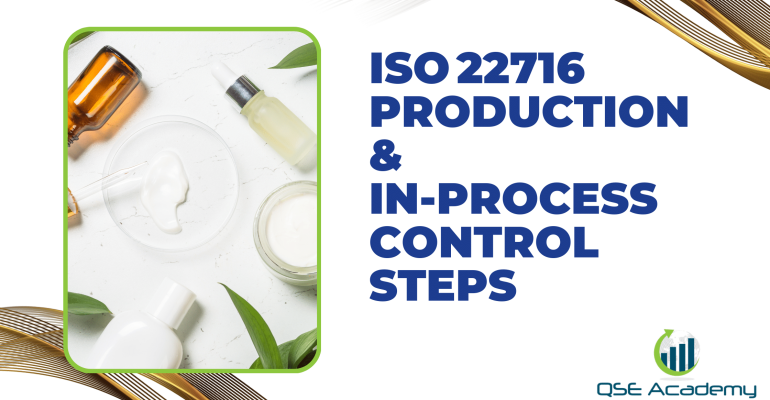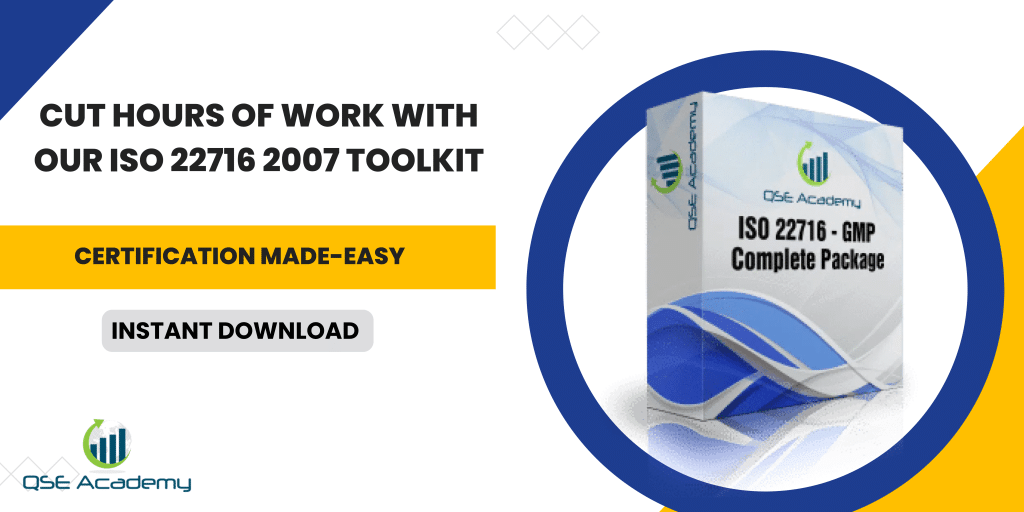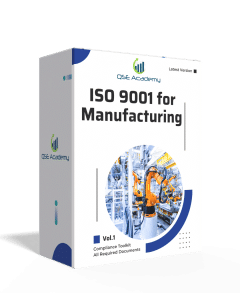ISO 22716 Production & In‑Process Control Steps
Last Updated on October 24, 2025 by Hafsa J.
Why Production & Process Control Matter in ISO 22716
If there’s one thing that separates a good cosmetic manufacturer from a great one, it’s control — not over people, but over processes. I’ve walked into plants where formulas were perfect on paper yet results varied from batch to batch. The issue wasn’t ingredients. It was process discipline.
ISO 22716 tackles that head-on. The standard lays out how every production step — from weighing to filling to labeling — must be planned, performed, and verified in a consistent, documented way. It’s about turning consistency into a habit, not an afterthought.
In this guide, you’ll learn:
-
What ISO 22716 requires for production and in-process controls.
-
How to keep every batch traceable and repeatable.
-
Common mistakes that lead to costly rework or failed audits.
-
Simple, proven tools to bring order and confidence to daily production.
When processes run smoothly, quality stops being something you check at the end — it becomes something you build in at every step.
Planning & Preparation for Production (Clause 7.1–7.2)
Every good batch starts long before the mixer turns on. ISO 22716 puts a strong focus on pre-production planning, because this is where most mistakes are either prevented—or quietly built in.
Before production begins, the standard expects a few fundamentals:
-
Raw materials released by Quality Control. Nothing moves until each component is approved and clearly labeled.
-
Equipment cleaned and ready. Surfaces must be verified clean and, if needed, re-sanitized before use.
-
Line clearance completed. The work area should be free from leftover labels, components, or products from the previous run.
-
Batch instructions available and understood. Operators must review the latest approved version, not yesterday’s draft.
In my experience, the biggest gap is communication between QA and production. A supervisor assumes everything is cleared, but QA hasn’t signed off yet—and the batch starts anyway. That’s an easy audit finding and a potential recall trigger.
Pro Tip:
Use a pre-production checklist signed by both QA and production before the first material is dispensed. It forces collaboration and catches small oversights before they become expensive.
Common Pitfall:
Starting production with “verbal confirmation.” ISO 22716 requires documented approval, not just trust.
When preparation is thorough and documented, the rest of the process runs smoother, and your team can focus on what matters most—consistent, compliant manufacturing.
Batch Manufacturing & Process Control Steps (Clause 7.3–7.4)
Once production begins, control becomes everything. ISO 22716 makes it clear: each batch must be manufactured according to approved instructions, with every critical step verified and recorded. No assumptions, no shortcuts.
Here’s what that means in practice:
-
Follow approved batch records — these define the formula, quantities, sequence, and process parameters like mixing time, temperature, and speed.
-
Perform in-process checks — pH, viscosity, appearance, or weight must be verified at defined intervals to ensure the product stays within specifications.
-
Document immediately — operators should record values as they go, not hours later when memory blurs.
I’ve seen facilities where production ran smoothly—until someone “forgot” to note a mixing speed. That single blank space led to a full investigation and a batch hold. The data trail is what protects you.
Pro Tip:
Use real-time batch monitoring sheets or digital input systems. They reduce transcription errors and give supervisors instant visibility into process trends.
Real Example:
A medium-sized cosmetics company I worked with introduced simple in-process checklists for each step—stirring, cooling, and filling. Within two months, rework dropped by 30%. They weren’t working harder, just more consistently.
Common Pitfall:
Skipping intermediate checks during long runs or relying on memory for settings. ISO 22716 expects objective evidence, not experience alone.
When every parameter, check, and signature is recorded in real time, traceability becomes second nature—and so does compliance.
Handling Deviations & Nonconforming Product
Even in well-run facilities, things don’t always go according to plan. A mixer runs too long, a pH test fails, or a label batch gets swapped. ISO 22716 expects you to handle these deviations in a structured, transparent way—because how you respond says more about your quality culture than the issue itself.
A compliant process includes:
-
Immediate identification of the deviation (who noticed it, what happened, and when).
-
Clear documentation in the deviation log or batch record, with all supporting data.
-
Impact assessment on product quality and safety.
-
QA involvement before any decision—whether it’s rework, rejection, or release under concession.
Here’s what I’ve noticed: too many teams “fix quietly” instead of documenting. A label was wrong? They reprinted it. A weight was off? They adjusted it. But without traceability, those fixes turn into findings during audits.
Pro Tip:
Treat every deviation report as a learning opportunity, not a punishment. Review root causes and feed them into your CAPA system. It prevents repetition and builds trust with your auditors.
Common Pitfall:
Reprocessing or blending out-of-spec batches without QA authorization. Even if the outcome looks fine, it breaks GMP integrity.
One cosmetic plant I advised used to have four to five deviations a week. After introducing a simple digital log linked to CAPA follow-up, they cut repeat issues by half. It wasn’t about new rules—just better visibility.
Documented deviations don’t make you look weak. They show that your process is alive, controlled, and continuously improving—exactly what ISO 22716 expects.
Environmental & Personnel Controls During Production
Production control isn’t just about what goes into your product—it’s also about what surrounds it. ISO 22716 expects manufacturers to keep a tight handle on the production environment and the people working within it.
During manufacturing, even small lapses can create big issues. Dust, hair, strong fragrances, or unfiltered air can compromise product purity. I’ve seen facilities produce excellent formulations that failed stability tests—simply because environmental controls weren’t consistent.
Here’s what good practice looks like:
-
Environmental monitoring: track temperature, humidity, and differential air pressure in production zones.
-
Controlled access: only trained, authorized personnel enter active production areas.
-
Hygiene standards: proper gowning, handwashing, and “no jewelry or perfumes” policies.
-
Cleaning between products: remove residues and sanitize surfaces before switching formulas.
Pro Tip:
Adopt a “one product per line” rule whenever possible. It simplifies cleaning validation and minimizes the risk of cross-contamination, especially for perfumed or colored formulations.
Common Pitfall:
Letting operators move between production lines without changing gloves or gowns. It seems harmless, but auditors see that as a clear hygiene control failure.
In one cosmetic plant I worked with, simple fixes—like dedicated smocks per zone and labeled footwear racks—cut contamination incidents to nearly zero within three months.
Your production environment should work for you, not against you. When personnel discipline meets controlled conditions, your batches become more consistent, your records cleaner, and your audits far easier.
Documentation & Batch Records Management
If you can’t prove it, it didn’t happen. That’s the golden rule in GMP. ISO 22716 takes this seriously—every step in production must be recorded, traceable, and legible. Documentation isn’t red tape; it’s the evidence that your process was under control from start to finish.
Here’s what ISO 22716 expects to see in your batch records:
-
Batch identification – product name, number, date, and operator.
-
Material traceability – lot numbers of raw and packaging materials.
-
Process parameters – mixing time, temperature, pH, weights, and in-process results.
-
Yield and reconciliation – actual vs. theoretical output with explanations for any loss.
-
Signatures – by the person performing, checking, and approving each step.
I’ve seen many facilities lose hours during audits because information was scattered—some in paper logs, some in emails, and some “in memory.” The best teams log data in real time, not later at the end of a shift.
Pro Tip:
Implement electronic batch records or digital checklists where possible. They reduce transcription errors and give QA instant access for review.
Common Pitfall:
Forgetting to record small adjustments—like adding water to correct viscosity. Even minor changes must be documented and approved. Leaving it out creates gaps in traceability that auditors will question.
Real Example:
One client I helped switched from handwritten batch sheets to a simple tablet-based log. Within weeks, data completeness jumped to 98%, and batch release time dropped by two days.
Good documentation isn’t about paperwork—it’s about building trust. Every signature and number tells a story: that your team followed the process, verified the outcome, and protected the brand’s integrity.
Line Clearance & Post-Production Review
When production ends, your job isn’t finished yet. ISO 22716 requires one final step before you can relax—line clearance and batch review. This is where you confirm that everything from materials to documentation is complete, clean, and correct.
Line clearance sounds simple, but it’s one of the easiest places to fail an audit. I’ve seen facilities pass every technical test, only to be marked noncompliant because labels, scoops, or leftover materials were still sitting on a bench.
A solid post-production control process includes:
-
Physical inspection of the line and equipment for leftover materials, labels, or product residues.
-
Cleaning verification—ensuring the area is ready for the next batch.
-
Batch record review—checking for completeness, missing signatures, or deviations.
-
QA release—no product leaves until documentation and cleaning records are approved.
Pro Tip:
Use a line clearance checklist signed by both Production and QA. Include photo evidence if possible. It proves control and protects you when auditors ask, “How do you know this line was cleared before the next run?”
Common Pitfall:
Rushing the clearance because another batch is waiting. Skipping verification steps can lead to mix-ups or cross-contamination—and that’s a serious GMP breach.
In one factory I advised, the QA team added a five-minute “clearance pause” before every new batch. That small discipline eliminated recurring label errors completely.
Post-production review isn’t bureaucracy—it’s your final quality safeguard. When you close every loop before the next batch, you send a clear message: nothing leaves your facility unless it meets your standard.
FAQs – ISO 22716 Production & In-Process Controls
Q1: What exactly are “in-process controls” under ISO 22716?
They’re the checks you perform during production to make sure everything stays within specification—like monitoring viscosity, pH, weight, or filling volume. Think of them as real-time quality guards. They confirm that the product you’re making now will match the one you released last month.
Q2: How often should production records be reviewed?
Every batch record should be reviewed immediately after production and before product release. Don’t wait for month-end or audits. Regular internal reviews—monthly or quarterly—also help spot trends, like recurring deviations or training needs.
Q3: Can nonconforming batches be reworked under ISO 22716?
Yes, but only with Quality Assurance approval and under a validated, documented process. The rework must not compromise product safety, stability, or traceability. Always attach the investigation and approval record to the affected batch file.
Q4: What happens if an in-process check fails?
Stop the process immediately and notify QA. Investigate the cause, assess the risk, and decide whether to correct, reprocess, or reject the batch. Continuing production without documenting or resolving the issue is a direct nonconformity.
Key Takeaways and Next Steps
Strong production control isn’t about perfection—it’s about consistency. ISO 22716 gives you the framework, but it’s your team’s discipline that turns procedures into predictable quality.
Here’s what really matters:
-
Every batch starts with preparation, not production.
-
In-process checks keep quality alive throughout manufacturing.
-
Deviations should be documented, not hidden.
-
Your environment, people, and records all need to work together.
In my experience, the most successful cosmetic manufacturers treat production control as a living process. They train their teams to think proactively, document everything in real time, and treat every batch as proof of their professionalism.
If you’re ready to bring that level of control to your facility, QSE Academy’s ISO 22716 Production Toolkit can help. It includes ready-to-use templates for batch records, in-process checklists, deviation reports, and QA release forms—everything you need to stay compliant and confident.
Take the next step toward flawless production — explore QSE Academy’s toolkit and build the systems that auditors respect and your customers trust.
Whether it’s ISO 9001, ISO 22000, or the cosmetics-focused ISO 22716, I’ve spent my career I’m not here to call myself an expert—I prefer “enthusiast” because I truly love what I do. When I’m not writing about standards, you’ll probably find me playing Piano 🎹, connecting with people, or diving into my next big project💫. I’m an engineer specialized in the food and agricultural industry
make ISO standards less intimidating and more approachable for everyone.
turning complex jargon into clear, actionable steps that businesses can actually use.
There’s something incredibly rewarding about helping people navigate food safety and quality management systems
in a way that feels simple, practical, and even enjoyable.
I have a Master’s in QHSE management and over 12 years of experience as a Quality Manager
I’ve helped more than 15 companies implement ISO 9001, ISO 22000, ISO 22716, GMP, and other standards
My clients include food producers, cosmetics manufacturers, laboratories, and service companies
I believe quality systems should be simple, useful, and efficient.











